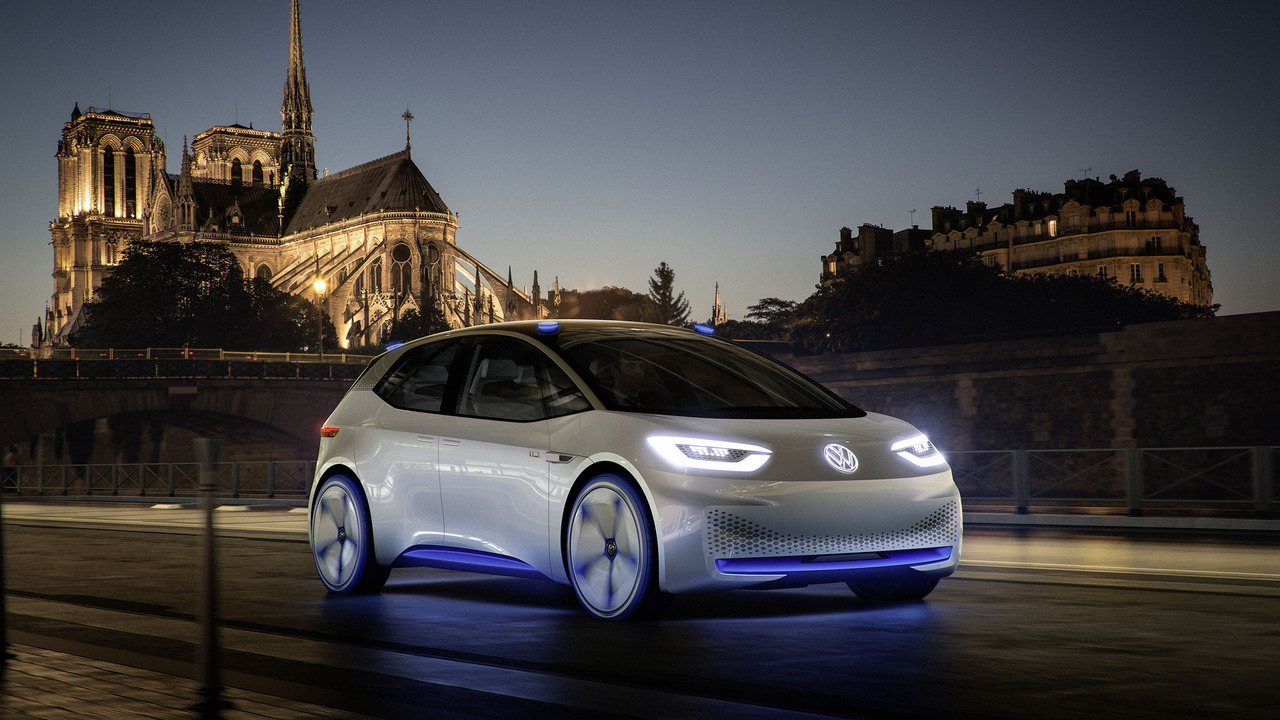After revealing a few details about the I.D Concept ahead of the Paris Motor Show, Volkswagen is now telling us everything about the potentially revolutionary electric vehicle. The production version of this model will debut in 2020 as the first vehicle in showrooms using the Modular Electric Drive Kit. The platform will eventually under a range of upcoming EVs.
VW integrates the I.D's 168-horsepower (125-kilowatt) electric motor and single-speed transmission into the rear axle. A flat battery is beneath the floor, which keeps the center of gravity low. The drivetrain would accelerate the hatchback to 62 miles per hour (100 kilometers per hour) in under 8 seconds, and the vehicle could reach a top speed of 99 miles per hour (159 kph). The company intends to offer multiple battery capacities that would provide between 249 miles (401 km) and 373 miles (600 km) on a charge on the European cycle. For reference, the region’s test generally indicates longer ranges than the more conservative evaluation in the United States.
The I.D measures 161.4 inches (4.1 meters) long, which is 6 inches (152.4 millimeters) less than the current Golf. However, the concept's wheelbase is five inches (127 mm) longer than VW’s popular hatchback. When the production I.D arrives in 2020, VW has the bold plan for its price to be on par with a comparably equipped Golf.
The concept's design moves the standard five-door hatchback into the future. Without the need to cool an internal combustion engine, the designers can create a smooth front end with very short overhangs. The headlights have a novel design with adaptive LEDs in the center that move around like eyes.
Inside, VW’s designers take an ultra-minimalist approach. The only physical button controls the hazard lights. Screens in the door panels let every occupant control the infotainment system, which seems like it could quickly lead to chaos. Rather than a gearshift, a capacitive panel on the bottom of the steering wheel lets drivers select Park, Reverse, Neutral, and Drive. Controls for the turn signals are also there.
The steering wheel also houses the control for the autonomous driving system. By pressing the VW logo in the middle for a few seconds, the wheel retracts into the dashboard. Laser scanners for navigating the vehicle then emerge from the roof like little antennae. VW thinks this tech could be ready for showrooms for 2025.









VW integrates the I.D's 168-horsepower (125-kilowatt) electric motor and single-speed transmission into the rear axle. A flat battery is beneath the floor, which keeps the center of gravity low. The drivetrain would accelerate the hatchback to 62 miles per hour (100 kilometers per hour) in under 8 seconds, and the vehicle could reach a top speed of 99 miles per hour (159 kph). The company intends to offer multiple battery capacities that would provide between 249 miles (401 km) and 373 miles (600 km) on a charge on the European cycle. For reference, the region’s test generally indicates longer ranges than the more conservative evaluation in the United States.
The I.D measures 161.4 inches (4.1 meters) long, which is 6 inches (152.4 millimeters) less than the current Golf. However, the concept's wheelbase is five inches (127 mm) longer than VW’s popular hatchback. When the production I.D arrives in 2020, VW has the bold plan for its price to be on par with a comparably equipped Golf.
The concept's design moves the standard five-door hatchback into the future. Without the need to cool an internal combustion engine, the designers can create a smooth front end with very short overhangs. The headlights have a novel design with adaptive LEDs in the center that move around like eyes.
Inside, VW’s designers take an ultra-minimalist approach. The only physical button controls the hazard lights. Screens in the door panels let every occupant control the infotainment system, which seems like it could quickly lead to chaos. Rather than a gearshift, a capacitive panel on the bottom of the steering wheel lets drivers select Park, Reverse, Neutral, and Drive. Controls for the turn signals are also there.
The steering wheel also houses the control for the autonomous driving system. By pressing the VW logo in the middle for a few seconds, the wheel retracts into the dashboard. Laser scanners for navigating the vehicle then emerge from the roof like little antennae. VW thinks this tech could be ready for showrooms for 2025.











Comment